KNIVAR från ESKILSTUNA
ESKILSTUNA CUTLERY
and
RUMINATIONS ABOUT
the
SWEDISH CHARACTER
by Clyde Shoe
It all started with selling an Eskilstuna champagne pattern knife to Reidar Remneson, a collector in Karlstad, Sweden – thus returning this stray to its homeland after a century abroad.
After Reidar and I established our mutual interests, Reidar said he knew I would enjoy a 1999 book, Knivar från Eskilstuna, published in Eskilstuna by Arne Marmér. Reidar said I would like the book just for its fine pictures, even though I could not read Swedish. Besides, he said, he would help with translations.
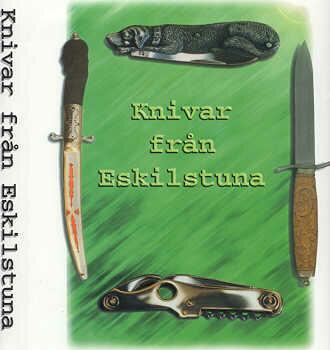
Book Dust Jacket
Swedes have a cavalier attitude toward foreign languages. Over the centuries Sweden has invaded, or been invaded by, most of its neighbors. Swedes are accustomed to foreign words and phrases. English is taught as a compulsory language in Swedish schools.
My only exposure to foreign language was elective French, a choice sincerely regretted by both my teacher and me. However, if you haven’t yet nodded off, you will see that my real talent lies in the Germanic languages, such as Swedish.
Reidar was right about my enjoying the book. It is hard cover, 256 pages of quality, slick paper, with hundreds of color pictures – a handsome production. Illustrated are many pictures of cutlery and of families of early company owners. Group photos of workers show that child labor was then common in Eskilstuna, as it was elsewhere.
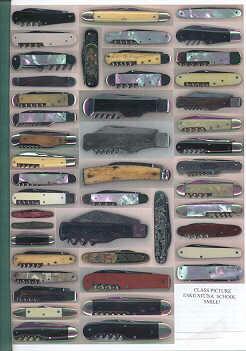
Book frontispiece
With dependable waterpower, timber for charcoal, and high-grade ore, Eskilstuna has been a cutlery center for about as long as Sheffield, England. Like Sheffield, its cutlery industry has been in long decline. Many dozens of firms are now reduced to one: EKA.
According to an account by Anders Dahlman of Lund, Sweden, found in Levine’s Guide IV, Eskilstuna metalworking started with a crude jolt. King Charles IX, reigning 1604-1611, needing a sure supply of armaments for his armies, ordered troops to destroy village smithies and march the smiths in chains to Eskilstuna. There they were put to work in consolidated forges and foundries. This marked the birth of the steel and cutlery industries in Eskilstuna. Think of this history the next time you see an Eskilstuna knife or corkscrew. I wonder how many ancestors of the people pictured in the book arrived in town in chains.
My language lack doubtless causes me to miss subtle points in the text, but my investigative skills carry me through. I quickly dope out that blad and korkskruv mean blade and corkscrew.
Context helps with längden (length), and och (and). I can’t decide if porterkrok is a beer or a beer opener. Sometimes a little vagueness creeps into my translations.
When I come across a word enough times, I look it up in a translation website. This usually suffices, but these sites have a limited vocabulary and cutlery has its own jargon. Too often the translation comes back, “No matches found.” Is it a coincidence that at this stage the website offers me An Easy Guide to Swedish Cursing? The offering goes on to say that “The Swedish language is rather limited when it comes to cursing and swearing.” Ah… shucks!
Sköldpadda means tortoiseshell, and I have been thinking of ways to slip sköldpadda into conversations. But I am naturally modest, shy, even, (everybody says so) and I hesitate to flaunt my new fluency.
If all this seems like too much trouble, it’s not. Hunting up words to translate words that may unlock the meaning of a sentence or paragraph – is like panning for gold. Crouching over the computer, surfing with the book at my elbow, I discover nuggets. If you read Swedish, you will get through the book faster; but it won’t be as much fun.
WHIM-WHAM
The book shows Hammesfahr and Müller corkscrew actions galore. It also pictures the bane of my repeated investigations, and that is knives with multiple, same-size corkscrews. Pictured are several knives with four corkscrews made by the firms of C. O. Ryd (1876-1918), Ljungkvis & Morell (1920-1941), and Emil Olsson (1896-1967). These knives all have wire worms, some left handed. (Bless those makers on behalf of all we left handers.) Fred O’Leary, author of the fine book, Corkscrews, reports that some Swedish knives bristle with as many as six corkscrews.
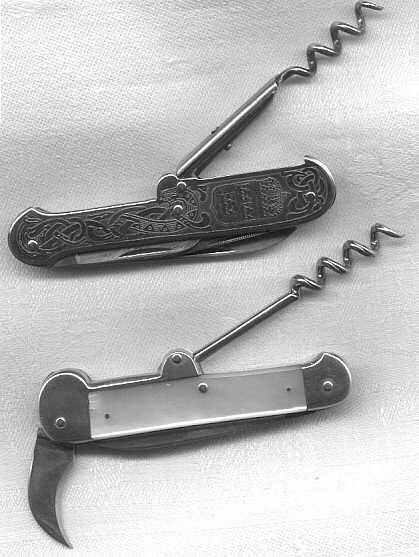
The metal_handled knife has a Hammesfahr 1897 patented worm: a swiveling, split shank. The pearl_handled knife has a 1896 M6ller patent: worm slides out of its pocket, hooks on the center pin. Both permit an extra long corkscrew, needed for long necked bottles with long corks.
Leapin’ Lutefisk! Six worms on one knife – a Gatling gun for corks! This corkscrew business is screwy.
No one has yet figured out how to operate more than one corkscrew on one knife at one time, even if the operator is ambidextrous. So why so many? Redundancy for breakage can’t explain it. The space shuttle doesn’t have that much backup. Whatever the answer, it must lie in Sweden, because that is the only place on earth where these curiosities were made. It is strictly a Swedish enigma.
I think of Swedes as a no-nonsense, practical people. The Swedish dairymen who are my Snoqualmie Valley neighbors certainly are. When a milk cow’s production at Oskar’s farm falls below a specified standard, Bossy gets a one-way ride to the knackers. Cows are contented at Oskar’s only as long as they produce. Oskar explains that sentiment here is impractical, fixing me with an eye that knows I don’t make my living in the milk trade.
Oskar also knows that I like old pocket knives. There is a purpose to showing me a knife he got from Sweden years ago. He doesn’t use it – too fancy.
He is much impressed that I find it in the Eskilstuna book: Emil Olsson, Nr 30. 2 blad och korkskruv. Längd 91 mm. Picture, too.
Straight away Oskar understands that his knife in my book gives him an advantage. I can see it in his face. Quick, is Oskar, but he doesn’t have a poker face.
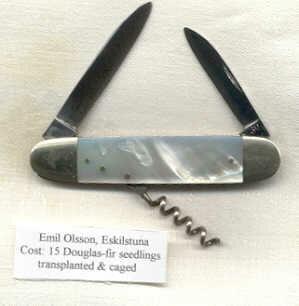
Emil Olsson, Eskilstuna
There isn’t much I have that Oskar wants, but he does want my seedling Douglas-fir trees. I figure this is why he brought the knife over to show me in the first place. Every move Oskar makes is planned.
I only have to give up fifteen trees for the knife, but I am also obliged to transplant them to Oskar’s farm, and I have to fabricate and erect wire cages around each tree to keep the deer away. Oskar shares a certain ruthlessness with King Charles IX.
Back in the old country, Swedes have long been practical planners. Visingsö, an island in Lake Vättern, has a magnificent old-growth oak forest. Its origin came to light in 1980 when the Swedish navy received a letter from the Forestry Department reporting that the ship lumber was ready. It turns out that in 1829 the Swedish parliament, recognizing that it takes 150 years for oaks to mature, and anticipating a shortage of timber for its navy in the late Twentieth Century, ordered two thousand trees planted and protected.
I am sure there is no small-minded reader who would point out that naval vessels are no longer made of wood. There is now great practicality in a mature oak forest – clean air for starters.
(This vignette of Swedish history – and character, I maintain – comes from Stewart Brand’s book, The Clock of the Long Now.)
While you may not agree with my assessment of Swedish character, you can see why I might first look for a practical reason for a knife festooned with corkscrews.
How about this. Eskilstuna cutlers could have made impractical corkscrew knives for a very practical reason: they were custom ordered.
Reidar talked with Buster Berntson, author of the book (with Per Ekman) Skandinavis ka Korkskrurar, and then sent me this translated excerpt:
In a chronicle for 1904 we found the following small notice: A few day ago, a cutler in Eskilstuna received an order from a large ironmonger in Stockholm for a knife with four corkscrews and a blade. The knife was immediately made and sent to the customer. Its maker is C. O. Ryd, it is tasteful and must be the rarest sort of knife that has yet been made..
From this account we learn that (a) C. O. Ryd would fill orders however odd they were, and that (b) this form of oddity was rare in 1904 Eskilstuna. There is no “(c)” because we still don’t know why the Stockholm customer ordered this oddity.
In writing his book Buster Berntson joins us in speculating about motivation:
Numerous corkscrews that are slightly exaggerated in design or are in some other way illogical in character have been made, and one wonders whether members of the cutlers guild unconsciously competed with one another. It seems as if they did in Eskilstuna.
Whoever might have had use for a knife with several corkscrews? We know of at least seven different four-corkscrew knives, of which the worms were left handed and right handed. Six of them are small and almost exaggeratedly well made. The seventh, which is unmarked, has only the form of a pocketknife, for it has no blade.
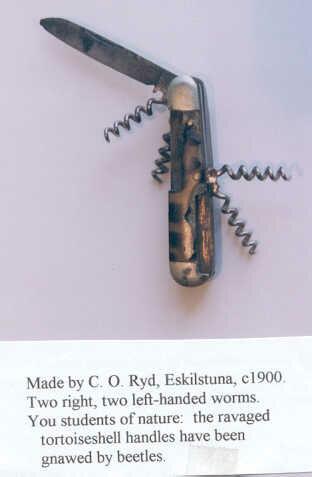
Hey! Speaking as a knife collector, that is going way too far. Just trying to be hospitable, you invite a twisted piece of wire onto your knife frame, and before you know it the worm turns, chucks out the blade, and invites all his relatives aboard. There goes the neighborhood.
My wife, Alice, says that I have stirred the pot, and it is just as murky as before. That is not entirely so. Out of this stirring I have concluded that Swedes can be whimsical as well as practical, and that is what same-size corkscrews are: sheer whimsy, and nothing more.
A whimsical object or device is called a whim-wham, and that is what I am going to call these corkscrew knives. Remember where you saw it first.
QUESTION: Why did the Swedes make so many corkscrew knives?
ANSWER: Because they had so many bottles to open in the long, cold, dark winters – medicine bottles, no doubt.
